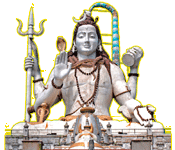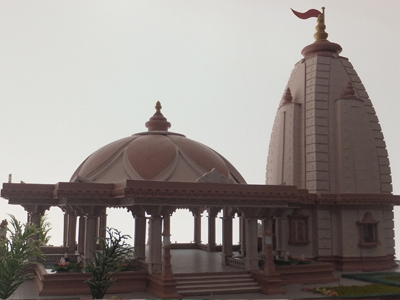
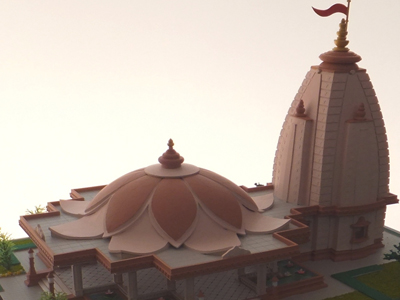
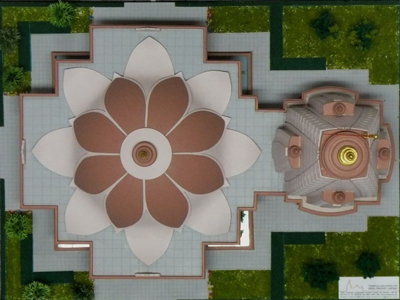
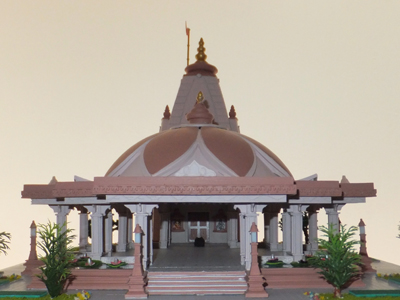
Shivji temple is designed for Reliance Utility Engineering Limited in their 4x300 MW Rosa Thermal Power Project at Rosa, Shahjehanpur, Uttar Pradesh. This Project has hundreds' acres land in their use. Hundreds' of staff members are going to stay there in project land. Reliance management has considered the requirement of religious structure for their families. A beautiful Lord Shiva temple is designed by Temple Architect Subhash Bhoite, M. Director of company; Temple Architects India Pvt Ltd for them.
SHIVJI TEMPLE:
Grand Lotus shaped Shiva Temple with 18' x 18' Garbha Griha and 50' x 50' Sabha Mandap with Entrance Porches from three sides. 4Nos. big Lotus Ponds around Sabha Mandap adding cooling effect to body and mind. Blossoming lotus flowers will definitely create smoothing effect to eyes and hearts also. Half round dome is designed above Sabha Mandap which is covered with inverted lotus flower. superbly designed landscape will enhance the loveliness of temple.
LORD SHIVA:
Main Deity of the temple is Lord Shiva. 3 feet high Narmadeshwar Shivlinga with 3 feet long black coloured stone Jaldhari will be placed at centre of Garbha Griha. Relief work of Shivji Pariwar with statues of Shree Ganeshji, Shree Shivji, Mata Parvati and Shri Kartikeya will be carved over Marble slab and fixed behind in rear side wall. Big size hanging Dhara Patra will be pouring water over the Shivlinga continuously. Auspiciously Designed False ceiling and beautifully designed marble flooring with semiprecious stones will add religious feel in the Garbha Griha.
1.Ground floor entrance hall with entrance porch.
2.Hall flooring will be plain. I.e. at one level to arrange all type of activities.
3.Ground floor hall will have capacity of 1000 loose seating chairs arrangements.
4.Hall will have one main entry and four exits for people.
5.Two Green rooms and two extra rooms for organizers with separate entries.
6.Stage platform about 1000 Sft area for programs.
7.Agni Havan Kund will be at South East direction of Temple Building built separately.
8.Utility unit (wash room) will be separate from temple building.
First Floor-Temple & Terrace as Parikrama Area
9.Temple Floor will have totally four stair case entries, two from front sides and two from rear sides. Front side stair cases will be used as entries and rear stair cases for exits at time of festival's rush period.
10.One Ramp and one Lift are provided at rear side (Tail of Tortoise) for old and disable devotees.
11.Hand wash and shoes stands will be arranged in separate structure near temple building.
12.Temple Sabha Mandap- Prayer Hall is big hall about 2500 Sft to accommodate more devotees in Sabha Mandap.
13.Designed less nos. of columns in Sabha Mandap to get clear view to all devotees.
14.Two octagonal Pyramids designed symmetrically above Sabha Mandap (instead of round domes, which are difficult to cast there in Mauritius). It is believed that Pyramidal structures absorb more cosmic energy from space; so it beneficial to stand or sit down under pyramids.
15.Totally Five Garbha Grihas are planned in temple.
I. Shivlinga at centre with statues of Shree Ganeshji, Shree Shivji, Mata Parvati and Shri Kartikeya behind the Shivlinga. Shivlinga: Black coloured Jaldhari with Narmadeshwar linga.
II. Shree Laxmi & Narayana Statues with back ground of Dasha Awtar on rear side wall carved in sand stone.
III. Main Deity Shree Rama, Shree Laxmana, Sita Mata & Hanumanji will be at central Garbha Griha.
IV. Shree Radha & Krishna statues with back ground of Vrindavana, where Gop and Gopikas are dancing Ras.
V. Statue of Mata Durga with background of other eight Matas making it Navmatas.
VI. Statue of Shree Hanumanji in meditation position will be placed in front of temple entrance with stone chhatri (half round dome) above entrance of ground floor.
16.Statues of Shri Ganeshji and Mata Saraswati will be placed in side Zarokas for Darshana. Saint Tulsidas & Saint Valmiki also will be placed with Zarokas in Sabha Mandap side walls. This will be remembrance of them who have written Shree Ramayana and gave us knowledge of it.
17.Providing toughen Glass partition with shutters to all Garbha Grihas' (Sanctum) from front side. This will give more vision to devotees. All Devotees can see all Deities at time of Arti & Puja from all corners. This glass work will give contemporary look to temple from inside. This way we can reduce total load of Garbha Griha walls over ground floor structure, and work will be more speedy and economical.
18.Total height of main Shikhar is 9 x 7 = 63 feet from ground level.
19.Suitable and extraordinary Marble or Stone cladding will be done in interior and exterior walls, Shikhar and all domes etc. considering heavy & continues rain fall in Mauritius. Combination of all types of Indian Temple Architecture will be unique feature of this stone work. Exterior & interior will be designed to create religious atmosphere in and around temple building.
20.A RCC statue of Shri Hanumanji about 21 feet may be erected between Ramayana Centre and Temple Building in future.
21.Good design of Landscaping with water fountain will enhance beauty and ambiance of Shri Rama temple and attract more & more devotees from the world.
Mrs. Tina Ambani is taking keen interest in this temple project. Management has appointed Mrs. Dina Amin as co-coordinator for this work. All of company's staff members also heartily cooperating in this temple project. Temple is under construction and will be constructed within period of 18 months.
Lord Shiva Story
(pron.: meaning "auspicious one"; is a Hindu deity. He is considered the Supreme God within Shaivism, one of the three most influential denominations in Hinduism. In other branches of Hinduism such as in the Smarta tradition, he is regarded as one of the five primary forms of God. He is "the Destroyer" or "the Transformer" among the Trimurti, the Hindu Trinity of the primary aspects of the divine.
Shiva is usually worshipped in the anionic form of lingam. He is described as an omniscient yogi, who lives an ascetic life on Mount Kailash, as well as a householder with a wife Parvati and two sons, Ganesha and Kartikeya and a daughter Ashoka Sundari. Shiva has many benevolent as well as fearsome forms. He is often depicted as immersed in deep meditation, with his wife and children or as the Cosmic Dancer. In fierce aspects, he is often depicted slaying demons.
In many holy texts and puranas like Mahavishnu, Shiva or Mahadeva is also called Paramatman (Supreme soul). Shaivas often see him as Parabrahma (Supreme Brahman), and is regarded as Bhagwaan by devotees. The Shiva Sahasranama (1000 names of Lord Mahadeva) declares Shiva as "Paramatman", the super soul found everywhere. He is commonly connected to the practice of Yoga.
Front entrance wall of Garbha Griha will be preciously designed with 2 Nos. of Zarokas housing 1 st quality white marble statues of 1) Ganesha and 2) Hanumanji.
Ganeshji Story
Ganesha (Sanskrit: also spelled Ganesa and Ganesh, also known as Pillaiyar, Ganapati and Vinayaka is one of the best-known and most widely worshipped deities in the Hindu pantheon. His image is found throughout India and Nepal. Hindu sects worship him regardless of affiliations. Devotion to Ganesha is widely diffused and extends to Jains, Buddhists, and beyond India. Although he is known by many other attributes, Ganesha's elephant head makes him particularly easy to identify. Ganesha is widely revered as the Remover of Obstacles and more generally as the Lord of Beginnings and the Lord of Obstacles, patron of arts and sciences, and the deva of intellect and wisdom. He is honored at the beginning of rituals and ceremonies and invoked as the Patron of Letters during writing sessions.
Hanumanji Story
Hanuman (also known as Anjaneya and Maruti) is a Hindu Deity and an ardent devotee of Lord Rama, a central character in the Sanskrit epic Ramayana. Folk tales increasingly eulogize the powers of Hanuman and he is considered an avatar or reincarnation of Shiva. The qualities of Hanuman, his strength, courage, wisdom, celibacy, devotion to Rama and the many names by which he was known is detailed in Hanuman Chalisa. There are more temples devoted to Hanuman than any other deity in India and recitation of Hanuman Chalisa is one of the common religious practices.
Hanuman Chalisa (Hindi: "Forty chaupais on Hanuman") is a devotional song based on Lord Hanuman as the model devotee. It is a poem written by Tulsidas in the Awadhi language, and is his best known Hindu text apart from the Ramcharitmanas. The word "chalisa" is derived from "chalis" in Hindi, which means 40, as the Hanuman Chalisa has 40 verses.
